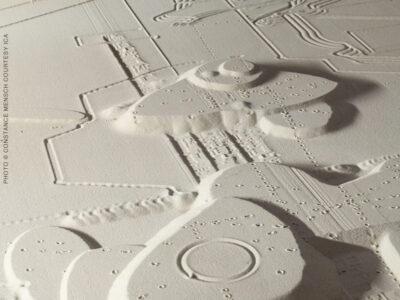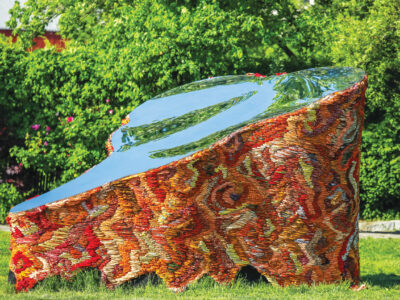
In October, the Sachs Forum in Contemporary Art hosted sculptor Richard Serra, fresh from a 40-year retrospective exhibition at the Museum of Modern Art in New York. Best known for giant abstract works crafted from curved sheets of rolled steel—the MoMA show weighed in at 550 tons—the 67-year-old artist actually started out as a painter. In conversation with Lynne Cooke, curator of New York’s Dia Art Foundation, Serra recounted how an encounter with Diego Velasquez’s masterpiece Las Meninas, which hangs in the Prado in Madrid, effectively ended his painting career—and spurred him toward sculpture in a rather unusual way.
I went back to Florence—it sounds like I was having a nervous breakdown—but I threw all my paintings in the Arno. Not only that … I threw all my colors in the Arno, and I threw all my brushes in the Arno. And I thought, Time to start over. I think one of the ways to get out of school is to really get out of school … Sometimes you really have to get it down to clearing the table and starting all over again. And that’s what happened to me after looking at Velasquez. …
I was living in Florence … and there’s a museum there where an early sculptor had done figurative cadavers where he had ripped them open between the throat and the crotch, and had splayed them apart. And I got completely fascinated. There was a certain kind of necrophilia, exotic/erotic intensity about them. And when I went to look at them, I kept thinking that the first zoos that were ever done were done in Florence. People collected the animals just to look at. I started thinking about the zoos, and this thing that I was attracted to because of its perverse intensity every day, and I thought, What if I just tried to make up my own zoo?
I had no idea what I was doing. I moved in about 17 animals into the place I was living, and I got a lot of different material and just threw it on the floor. I was really curious to see what the animals would do in relation to the material—whether they would make their own habitats. And the kind of habitats they would make, could I use what they were making in relationship to what I wanted to make?
Did I really know what I was doing? I hadn’t the faintest idea. At that point I knew I couldn’t keep doing what I was doing. I knew that Velasquez had forever killed it off for me. So I really wanted to start with sticks and stones. And I thought, I was in Florence, zoos were there, there were animals around, I didn’t have any money, and so I really just started dealing with live animals. And then trying to make hides and stuff animals and get into some very silly illusion of what’s real and what’s not real. I mean, it was on that basic level.
And I had a show in Rome of live and stuffed animals. There was a big pig in the show, and the police came and called it ignoble brute, and they closed the show down, and we got an injunction and opened it back up. …
When I got back to New York, I knew I couldn’t keep dealing with live and dead animals. But the idea of dealing with matter and material, in relation to forming, really became the subtext of what I wanted to do.
—T.P.




